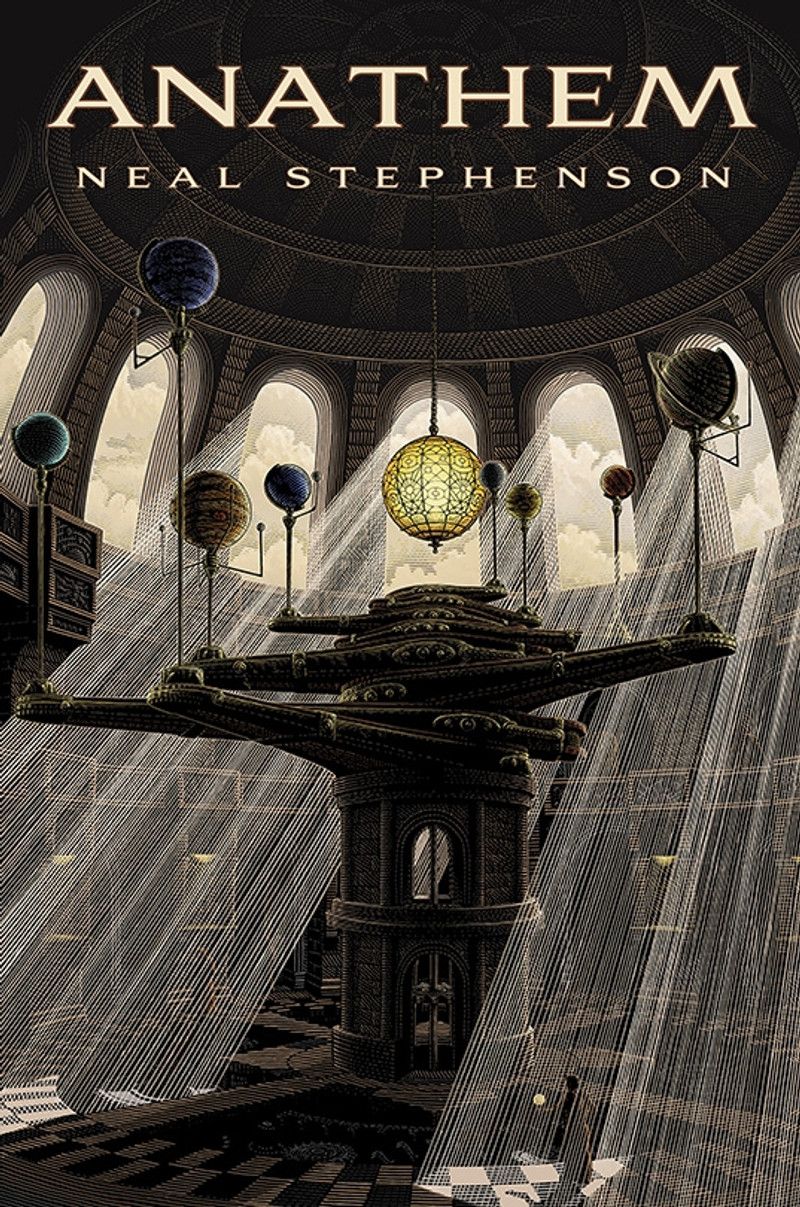Somewhere in the mountains near Van Horn, Texas, a hollow 500 foot cylindrical passage cuts though the rock. Within this cylinder is a giant mechanical clock, designed to keep time for the next 10,000 years. This is the Clock of the Long Now, an ambitious project by the Long Now foundation. The clock uses mostly bronze age technology, designed to be easy for future generations to understand and repair. The material was chosen to be as unattractive to looters as possible. Carved into the cavern’s walls twirls a spiral staircase.
Every 10, 100, and 1000 years, bells echo through the hollow insides of the Clock of the Long Now. Haunting and complex, the melodies that ring out were created with the help of Brian Eno. It’s fascinating to imagine future societies visiting this mechanical marvel to listen to it’s chimes.

In Anathem, Stephenson envisions one such society, albeit not in our own universe. Anathem takes place on Arbre, a planet with numerous parallels to our own history and culture on which such a clock exists and is tended to and revered by a religious order of avouts. In his acknowledgements, Stephenson cites the Clock of the Long Now as his inspiration for Anathem.
Anathem is an initially dizzying work, throwing the reader head-first into the deep lore of Arbre. Stephenson paints a picture of a planet with a rich cultural heritage, complete with competing philosophical schools of thought, fallen empires, religions, governments, futurist technologies like gene splicing and “new matter”, a strange substance used to create objects that don’t obey the normal laws of physics.
Anathem’s plot advances at a slow crawl throughout the first third of the book, with much energy spent on deepening one’s sense of immersion in the world. Stephenson’s world building is extremely rich and detailed. As one begins to understand the world, the excitement and intrigue deepens, even if much of it goes over your head.
Anathem is an overall enjoyable read, but sometimes dry. A truly philosophical novel, it explores the of the nature of reality, philosophy of mind, quantum physics, the multiverse, phenomenology, epistemology, idealism, social commentary, hedonism, geometry, and more. Recognizing the parallels between Arbre’s culture and our own proves to be good fun.
Philosophical dialogues and thought experiments are woven all throughout Anathem. Stephenson is not shy about taking lengthy detours from the plot for the sake of these discussions. Although the ideas are at times interesting, these scenes often read like Stephenson talking to himself rather than two unique personalities interacting. If you’re looking for a character-driven novel, this certainly isn’t for you. This is the work of a high analytical mind. There isn’t much character development; it’s the world of Arbre that ends up changed, not the characters. I was often left wondering what would motivate characters to act in the way they did. The only conclusion I could come to was that the plot was imagined first and the characters are just along for the ride.
This gives Anathem a consistently unemotional tone. The inner lives of the characters, beyond their opinions and beliefs about philosophy and problem-solving, are largely opaque. Moments where emotion should be present are glossed over. There are some love affairs, but these do not receive much detailed attention, and largely fall flat. Sometimes Stephenson pays lip service to the emotion that should be there, but quickly moves on in service of the plot or more philosophical musings. Erasmus’ sorrow and suggested suicidality at the beginning of the book is never developed at all after being introduced.
Despite the character flatness, it wasn’t terribly difficult to find the motivation to pick up Anathem. The plot progresses at a slow burn, steadily enough to hold your attention, and the philosophical themes create a sense that something big is happening beyond one’s awareness.
Stephenson is a good writer. The tone of the prose is light, precise, matter-of-fact and often times comical, but never did I stop to admire a well crafted sentence or clever turn of phrase. It’s just not that kind of book. Stephenson uses language as a tool, a vessel for the story rather than an end in itself. And that’s fine. This is sci-fi, fundamentally, not literary fiction. Not that there’s a hard line between the two, but know what you’re getting into. It’s better than many other sci fi books I’ve read, though, and more interesting.
The book is, however, far too long. It finishes just over 930 pages, and one can’t shake the feeling that certain scenes didn’t need to be there to make the book and enjoyable read. Stephenson spills gallons of ink describing in explicit detail the intricacies of his imagined architecture, technology, and the exact movements characters make as they navigate through the world and escape sticky situations. Sometimes it’s simply far too much information and reads less like a novel and more like a textbook.
Perhaps this is the scientist in Stephenson, his felt obligation to show his work, his reasoning, and to bullet proof his world against accusations of internal inconsistency or scientific implausibility. He’s brilliant, to be sure, and his dedication to world building is admirable. You could study the various schools of thought he imagines if you were so inclined. But sometimes one can’t help but beg him to get to the point.
⁂